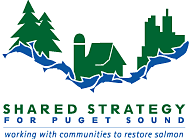|
Building Support for Salmon and Watershed Health Neighbor to Neighbor A pilot project in the Tenmile Creek watershed in Lynden, Washington proves that actions can benefit both people and salmon. A partnership with local property owners, the Whatcom Conservation District (WCD), Nooksack Salmon Enhancement Association (NSEA) and the WA Department of Ecology (DOE), the Tenmile Creek pilot is a grassroots riparian restoration program to improve water quality in the streams and ditches that run through private property. The goal of the project is to improve the health of the streams, including wildlife habitat, while maintaining the ability to farm and work the land. “I believe farmers are willing to manage their land in a responsible manner,” said Jason Vander Veen, one of the project’s participants and President of the Whatcom County Agricultural Preservation Committee. “Working together with our landowners, our communities, and our local government, we will make a difference.” It all began with a neighborhood meeting back in 2001. As part of the project, landowners invite their neighbors to a meeting in their home to learn about the needs of their watershed and what they can do to make a difference. Education is an important aspect of this project. “Many landowners didn’t know what a watershed is or the water quality problems we have,” explained Dorie Belisle, the Project Manager and an apple farmer in the neighborhood. “They asked me to walk the stream with them,” Belisle went on to say. “They had ideas in their head and wanted to do something to help but it had to make sense for the conditions on their land. It had to meet their needs too.” In a 2002 landowner survey conducted by Belisle, 80% of the respondents (out of a total of 119) agreed that saving salmon was important to them. 63% agreed that changes to improve water quality can go hand in hand with their land use. 94% agreed that a community working together can improve water quality in a watershed. 79% said the best way to improve water quality is through community effort with some financial assistance from the government. “There isn’t a single farmer who doesn’t like fish,” said Belisle. “They’re just afraid they’ll lose productive land or have to deal with more regulations than they are able to cope with. The survey told me that most of them want to do something now. That way, we end up with a healthy watershed and if the fish come back, we’ll be ready for them.” The project’s tailored approach seems to be working. Landowners who would otherwise not participate in riparian plantings have planted thirty-five foot buffers on their land. This way they receive permits to dredge the reed canary grass out of the ditches and creeks, improving the drainage on their land as well as providing potential fish habitat. Washington State University Extension helps with collecting baseline data on temperature and dissolved oxygen and will monitor changes over the life of the pilot. Participating landowners agreed to adaptive management based on the data collected. What are the plans once the Tenmile Creek pilot project is concluded? “We are looking for additional funding to complete the work here first,” Belisle explained. “But we have talked about moving this approach into sub-basins with Chinook. This pilot has taught us that a voluntary, sub-basin approach works to reach people who might not otherwise get involved.” |
||||||||||||||||||||
